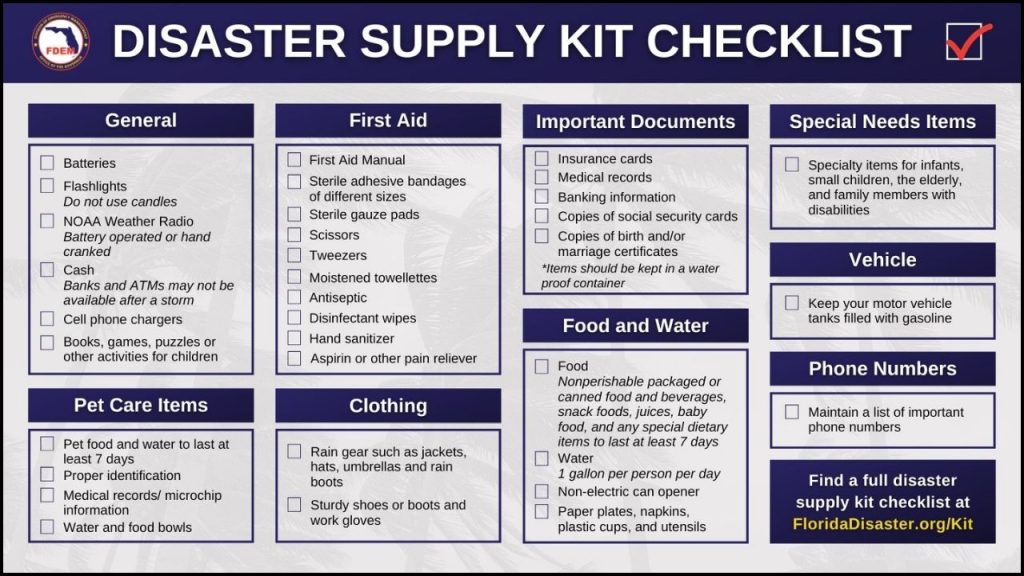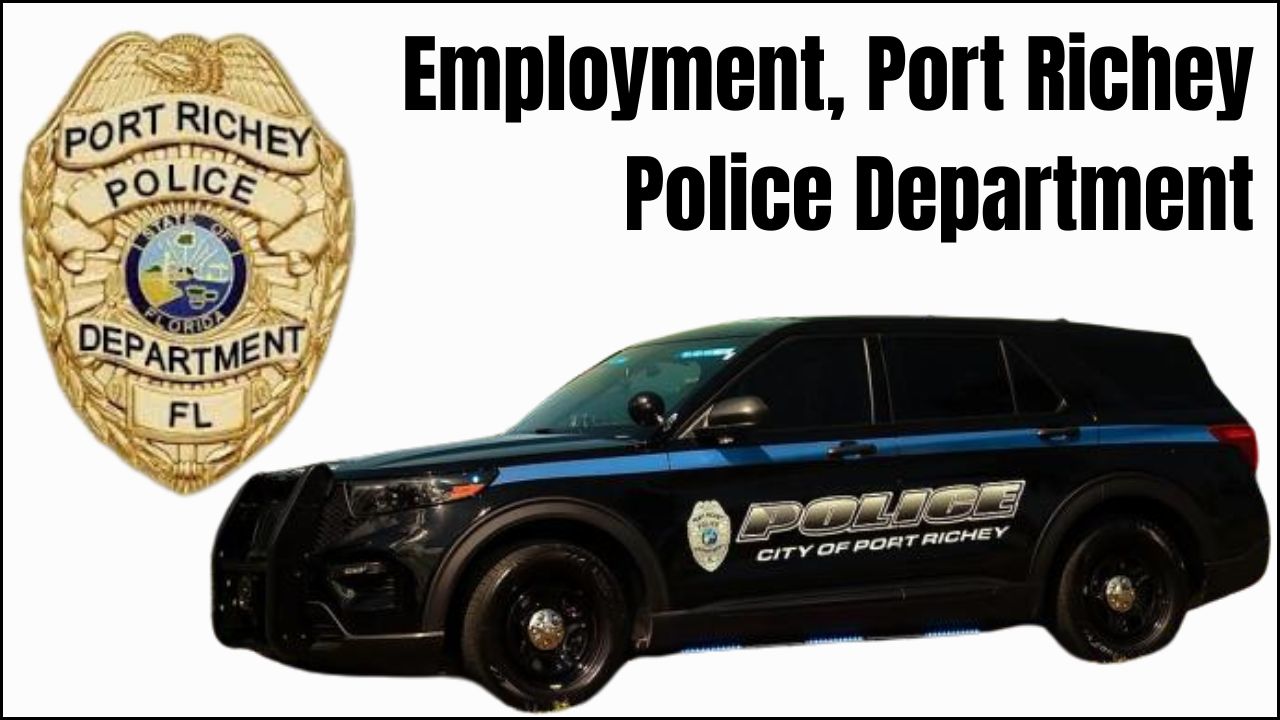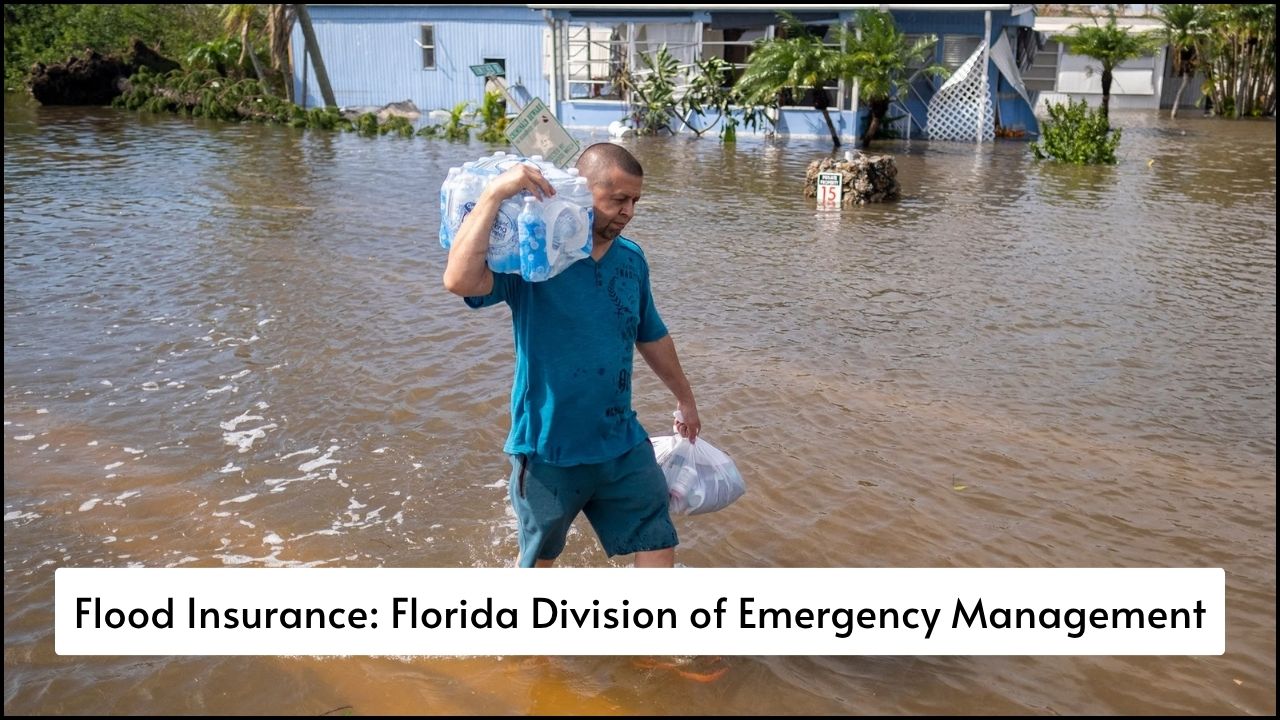
A disaster supply kit can save lives when emergencies strike. Natural disasters like hurricanes, floods, and tropical storms are common in Florida. The Florida Division of Emergency Management encourages everyone to keep a well-prepared supply kit. A carefully packed kit ensures that people stay safe, healthy, and informed during emergencies. This guide covers what to include in your kit and how each item can help after a disaster.
Table of Contents
Basic Items to Include in Your Disaster Supply Kit
Essential Items: These are the most important things that every household should have during an emergency.
| Item | Purpose |
|---|---|
| Water (1 gallon per person per day) | For drinking and hygiene purposes, enough for at least 7 days |
| Non-perishable food | Canned or dry food that can last at least 7 days |
| Manual can opener | Helps open canned food without electricity |
| Battery-powered or hand-cranked radio | Keeps you informed about emergency updates and weather alerts |
| Flashlights | Provides light when there is no electricity |
| Extra batteries | Power flashlights, radios, and other devices |
| First-aid kit | Treats injuries like cuts, burns, or infections |
| Medications (7-day supply) | Ensures medical conditions are treated without interruption |
| Multi-purpose tool | Useful for cutting, opening packages, or making quick repairs |
| Personal hygiene items | Includes soap, toothbrush, toothpaste, and feminine products |
| Face masks | Helps protect from dust, mold, or viruses |
| Important documents | Includes ID cards, insurance papers, and medical records in a waterproof bag |
| Cell phone with charger | Keeps communication open if cellular service is available |
| Cash or traveler’s checks | Used when ATMs and card machines don’t work |
| Blankets or sleeping bags | Keeps you warm if you need to sleep away from home |
| Extra clothes | Useful in case of floods or extended stays outside your home |
Special Items for Families with Specific Needs
Personalized Items: Different families have different needs. The items below are useful for babies, older adults, and pets.
| Category | Items to Pack |
|---|---|
| Babies | Diapers, baby wipes, baby food, formula, bottles, small toys |
| Older adults | Hearing aids with extra batteries, walking stick, dentures, eyeglasses |
| Pets | Pet food, leash, collar, medications, carrier, waste bags, ID tags |
| People with disabilities | Medical devices, power backup, communication cards, mobility aids |
Food and Water Resource Timeline After a Disaster
Availability Timeline: The Florida Division of Emergency Management shares how long it might take to get help after a disaster. Supplies may not arrive immediately.
| Days After Landfall | Expected Situation |
|---|---|
| Day 1 | Emergency crews begin search and rescue; limited access to food and water |
| Day 2 | More rescue operations, food, and water still mostly from personal supplies |
| Day 3 | Initial relief supplies begin to arrive in some areas |
| Day 4 | Food and water distribution expands, but may not reach remote areas |
| Day 5 | Community assistance improves; temporary shelters are better stocked |
| Day 6 | Relief efforts are more organized; more locations receive supplies |
| Day 7 | Most communities begin receiving necessities regularly |
Helpful Extras for Comfort and Convenience
Non-Essential but Useful Items: These items may not be critical, but can help reduce stress and improve comfort during tough times.
| Item | Benefit |
|---|---|
| Books, puzzles, games | Provides mental relief and entertainment during long waits |
| Local maps | Helps navigate when GPS and apps stop working |
| Whistle | Alerts rescuers to your location if you are trapped or lost |
| Duct tape | Temporary fixes for broken items or sealing leaks |
| Mosquito repellent | Reduces the risk of bites and diseases from insects |
| Sunscreen | Protects skin during cleanup activities in open areas |
| Trash bags | Keeps the area clean and can be used for multiple purposes |
How to Store and Maintain the Kit
Storage Tips: Proper storage keeps the kit ready and usable when needed most.
- Keep your kit in a cool, dry place.
- Use waterproof containers or bags.
- Store the kit where it is easy to grab quickly.
- Make one kit for home and a smaller one for your vehicle.
- Check and replace expired items every six months.
- Update kit contents after family changes (e.g., a new baby or pet).
Checklist for Fast Packing
Check the One-Page Checklist below.
Water & Food
- Water (1 gallon per person per day)
- Food (7-day supply)
- Manual can opener
Lighting & Power
- Flashlight
- Batteries
- Phone charger
- Radio (battery-operated or hand crank)
Health & Safety
- First-aid kit
- Prescription medications
- Face masks
- Multi-tool
- Personal hygiene supplies (toothbrush, soap, etc.)
Documents & Money
- Personal ID cards or documents
- Insurance papers (health, home, etc.)
- Medical records
- Cash in small bills
Comfort & Extras
- Blankets or sleeping bags
- Extra clothes (season-appropriate)
- Entertainment items (books, cards)
- Paper maps or printed directions
- Whistle for signaling
- Duct tape for emergency repairs
Family Needs
- Baby items (diapers, formula, wipes)
- Special items for elderly family members (medications, mobility aids)
- Pet supplies (food, leash, carrier)
Tips from the Florida Division of Emergency Management
Key Suggestions
- Build your kit before hurricane season starts.
- Don’t wait until a storm is near to buy supplies; items may run out.
- Include every household member when planning the kit.
- Review evacuation routes and shelter locations in your area.
- Download the official checklist PDF for regular updates.
Last Words
A disaster supply kit offers more than just convenience; it offers safety and confidence. Families in Florida face various weather emergencies every year. Preparing the kit in advance helps avoid panic and gives peace of mind. A few hours spent planning can make a big difference in the days after a disaster. Always keep your checklist nearby and your supplies ready to use.





